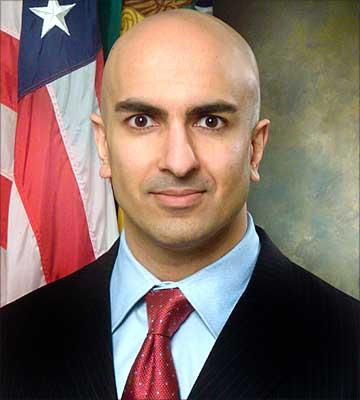CIA counter-culture, flower power, the new immigration law of 1965...and IT, and Silicon Valley in the 1990's, motels, petrol stations and convenience stores, and sheer hard work that would put many Americans to shame.
.
.
.
.
The USA somewhat Imperialistically was always more interested in China, in the same way the British were focused on South Asia........all for the wrong reasons of-course, based on missionary zeal, racism, unhealthy intra-national competitiveness which was linked to the confidence of the new power to show and TEACH the ancient civilizations how things should be done.
For many years Indians were 'invisible' to Americans, save for Hollywood propaganda films which bolstered the British empire, especially running up to the critical years of WWII.
But now Indians in the USA are making their presence felt and are progressing in all areas. It helps vis a vi the UK that most Indians to the USA are young and already well educated.
There are over 3 million Indians in the USA, the third largest ethnic immigrant group after the Chinese, and Latinos.
3 Cheers to the USA! Hip Hip Hurrah..Hip Hip Hurrah
....Hip Hip Hurrah !!!


 From Wikipedia:
.
Model minority refers to a minority group (whether ethnic, racial or religious) in certain countries whose members are most often perceived to achieve a higher degree of success than the population average. This success is typically measured in income, education, and related factors such as low crime rate and high family stability.
From Wikipedia:
.
Model minority refers to a minority group (whether ethnic, racial or religious) in certain countries whose members are most often perceived to achieve a higher degree of success than the population average. This success is typically measured in income, education, and related factors such as low crime rate and high family stability.
Educational Attainment: 2010
(25 and Older)
| Ethnicity |
Bachelor's Degree
or Higher |
| Indian |
71.1% |
| Chinese |
52.4% |
| Filipino |
48.1% |
| Total US Population |
28.0% | | | | | | | | | | | | | |
.
.
According to the 2010 U.S. Census, Indian Americans had the highest household income of all ethnic groups in the United States.($95,000.........USA average $50,000)
Among Indian Americans, 72.3% participate in the U.S. work force, of which 57.7% are employed in managerial and professional specialties.[41] As of 2010 66.3% of Indian Americans are employed in select professional and managerial specialties compared with the national average of 35.9%.[42]
In 2002, there were over 223,000 Asian Indian-owned firms in the U.S., employing more than 610,000 workers, and generating more than $88 billion in revenue.



 _________________________________________
_________________________________________
Indians are third largest immigrant group in US
By Times of India.
Indians
have emerged as the third-largest immigrant group in the US behind
Mexicans and the Chinese with their number touching nearly 1.9 million
in 2011, according to a US think tank.
The share of Indian
immigrants among all foreign born in the US has grown to almost 5
percent of the country's 40.4 million immigrants in 2011, noted an
article published in the Migration Policy Institute's online journal, the Migration Information Source.
Indian population has grown to over 150 times its size since 1960, when
the slightly more than 12,000 Indian immigrants represented less than
0.5 percent of the total immigrant population of 9.7 million immigrants.
Indians' share of Asian immigrants in the United States has been increasing steadily since 1960, making it the third-largest sending country overall and the second-largest Asian sending country after China.
As a group, immigrants from India are better educated, more likely to
have strong English language skills and arrive on employment-based
visas, and are less likely to live below the federal poverty line than
the overall foreign-born population, it says.
They are also
more concentrated in the working ages than immigrants overall, and
Indian-born men outnumber Indian-born women. In 2011, India was the
second most common country of origin for international students at US institutions of higher learning, behind China, MPI noted.
Based on data from various US government reports, the article noted that Almost one-third of all Indian immigrants resided in just two states:
California (380,700 or 21 percent) and New Jersey (210,400, or 11 percent).
Other states with Indian immigrant populations greater than 100,000
were Texas (162,400, or 9 percent); New York (145,400, or 8 percent);
and Illinois (127,200, or 7 percent).
In terms of share of the
states' respective immigrant populations, the Indian born made up 12
percent of all immigrants in Delaware, 11 percent in New Jersey, and 10
percent in Ohio.
More than one-quarter (508,200 or 27 percent)
of all Indian immigrants lived in three major metropolitan areas:
greater New York (304,300 lived or 16 percent, Chicago (114,000 or 6
percent), and San Jose (90,000 or 5 percent).
Other
metropolitan areas with Indian-born populations greater than 60,000 were
San Francisco, California (86,800, or 5 percent), Washington, DC
(82,300, or 4 percent); Los Angeles, California (82,200, or 4 percent);
Dallas, Texas (66,100, or 4 percent); and Philadelphia, Pennsylvania
(62,200, or 3 percent).
In terms of share of cities' respective
immigrant populations, the Indian born made up 15 percent of all
immigrants in Trenton, New Jersey; 14 percent in Richmond, Virginia and
14 percent in Raleigh-Cary, North Carolina.
According to the
Institute of International Education, students from India accounted for
13 percent (100,270) of the 764,495 international students studying at
US institutions of higher learning during the 2011-12 academic year.
India was the second largest origin country of international students
in the United States, behind China (25 percent of international students
in the United States).
More than 29 percent of employed
Indian-born men worked in information technology occupations, while 19
percent of employed Indian-born women worked in management, business, and finance.
The top three occupations that employed Indian-born men ages 16 and
older were information technology (29 percent of all 717,000 Indian male
workers); management, business, and finance (21 percent); and sales (11 percent).






